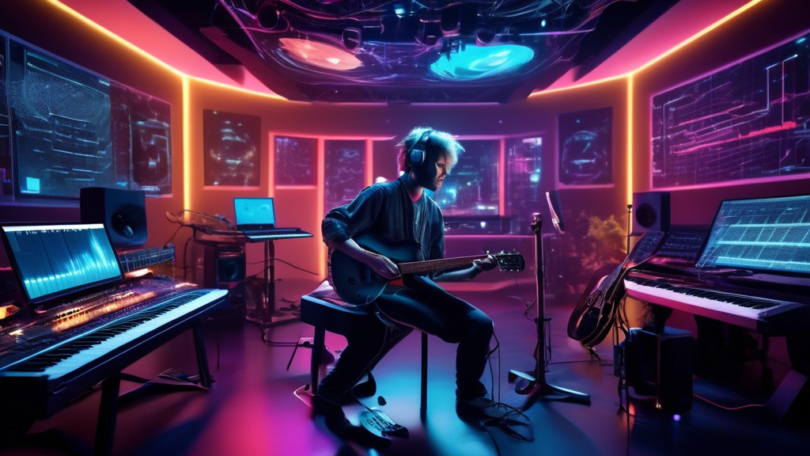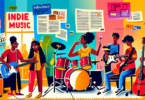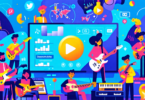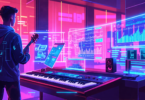In an age where technology steadily reshapes every facet of our lives, the music industry is no exception. Artificial Intelligence (AI) has emerged as a revolutionary force in music production, offering unparalleled capabilities in composition, mastering, and even performance. Yet, despite these advancements, the quintessential human traits of creativity, emotion, and personal expression remain irreplaceable pillars of musical artistry. This juxtaposition raises a compelling question: how can we foster a harmonious coexistence between AI and human creativity in the realm of music production?
To begin with, it’s essential to understand how AI technology infiltrates the music scene. AI algorithms can analyze vast datasets of music, identifying patterns, styles, and trends at speeds human minds simply cannot match. These algorithms can compose melodies, arrange harmonies, and even predict the next big hit based on existing data. On the other hand, human creativity embodies the soul of music — years of emotional experiences, cultural influences, and personal ingenuity, all culminating in a unique artistic journey. Unlike AI, humans inject intangibles such as soul, passion, and spontaneity into their creations, producing works that resonate deeply on an emotional level.
Striking a perfect balance between these two elements is critical in modern music production. AI offers incredible efficiency, freeing up time for artists to focus on the intricate details that machines cannot capture. It can process feedback loops swiftly, modify compositions in real-time, and even assist with the technical aspects of sound engineering. However, the human element ensures that music remains a deeply personal and emotionally engaging experience. Musicians can impart nuances and improvisations, making each piece a unique testament to their individuality.
The integration of AI in music production yields a promising blend of technical prowess and emotional depth. By leveraging AI’s analytical strengths alongside human creativity, artists can explore new frontiers of musical expression. This symbiotic relationship not only augments the capacity for innovation but also preserves the emotional richness that has always defined great music. Ultimately, the future of music production may lie in this delicate balance, where human emotion and machine precision converge to create works that are both technically proficient and profoundly moving.
Introduction: The Intersection of AI and Human Creativity in Music Production
The intersection of artificial intelligence (AI) and human creativity in music production is a burgeoning field that’s redefining how music is composed, produced, and even perceived. In essence, AI technology in music uses advanced algorithms, machine learning, and vast data sets to analyze, generate, and modify music. This involves everything from composing new melodies to adding appropriate accompaniments, and even mastering tracks for professional-quality sound. AI technology doesn’t require rest, can analyze countless datasets in moments, and never tires of testing endless possibilities. This efficiency makes it a powerful tool in the hands of music producers and artists.
While the reach and functionality of AI in music production are impressive, human creativity remains an irreplaceable force. Human creativity brings a level of emotion, expression, and artistry that algorithms cannot replicate. Musicians pour their personal experiences, cultural contexts, and instinctual choices into their creations, resulting in music that can evoke deep emotions, inspire movements, and become timeless pieces of art. These elements stem from a complex interplay of brain chemistry and an artist’s unique perspective, which cannot be fully synthesized by AI.
Striking a balance between the technical prowess of AI and the nuanced artistry of human creativity is crucial for modern music production. Relying solely on AI could lead to music that, while technically proficient, might lack emotional depth and individuality. Conversely, refusing to embrace AI tools might place limitations on the speed, scope, and potential innovation in music production. It’s about finding a symbiotic relationship where AI can manage repetitive, data-heavy tasks and enhance the creative process, thereby allowing human artists to focus more on the creative aspects that demand a human touch.
Explanation of AI Technology in Music
AI technology in music is fundamentally about applying computational techniques to understand and create music. There are several methodologies and technologies used, including:
- Machine Learning: Machine learning involves training algorithms on large datasets of music to identify patterns. These patterns can then be used to compose new pieces of music that adhere to specific styles, genres, or structures.
- Deep Learning: A subset of machine learning, deep learning utilizes neural networks that mimic the human brain, making it capable of understanding more complex relationships within music. This is particularly effective in creating nuanced musical compositions.
- NLP (Natural Language Processing): Used in lyric generation, NLP helps in understanding the structure and semantics of human languages, allowing AI to craft lyrics that convey specific emotions or messages.
- Algorithmic Composition: This involves using predefined rules or algorithms to generate music. Historically, these can be traced back to methods like the twelve-tone technique by composers like Arnold Schoenberg.
By leveraging these technologies, AI tools can assist in numerous music production stages, from composition and arrangement to sound design and mastering. These tools can analyze vast amounts of existing music to generate new yet stylistically consistent compositions or suggest improvements for existing ones.
Overview of Human Creativity and Emotion in Music
Human creativity in music hinges on individual expression and emotional depth. Creators draw from their life experiences, emotional states, and personal influences, creating works that resonate on a deeply emotional level. This emotional connection is often what attracts audiences, making music a profound and universally understood form of art. Every decision a human artist makes, whether it’s an unexpected key change, a tempo modulation, or an improvisational flourish, adds a layer of soul that is difficult for AI to emulate.
Moreover, human creativity isn’t bound by rules or datasets. Sometimes, disruption and deviation from norms birth new genres and styles. From the emotive phrasing in a jazz solo to the raw energy of a punk rock performance, these elements of unpredictability and personal touch are what make human-created music continually inspiring and evolving. Emotional expression, spontaneity, and the personal touch are intrinsic to human creativity, shaping music into a form of communication that transcends language and culture.
Importance of Balancing Both AI and Human Input in Music Production
The quest for a harmonious balance between AI and human involvement in music production lies at the heart of innovation. AI can take a significant load off the technical and labor-intensive aspects of music production. For example, it can quickly generate different variations of a melody, allowing the human artist to select and refine the one that best fits their vision. It can also handle tasks like mixing and mastering with a level of precision that enhances overall sound quality and reduces production time. Such efficiency allows human artists to devote more energy to the creative process, exploring new ideas and emotional expressions.
Yet, the final touch, the emotional essence, and the innovative spark will always belong to human creators. AI algorithms lack the ability to understand the cultural and emotional contexts that often drive creativity. Human decision-making, characterized by intuition, emotional intelligence, and personal experiences, ensures that the music remains authentic and dynamic. By using AI as a powerful tool rather than a replacement, musicians can achieve a new level of productivity and creativity, pushing the boundaries of what is possible in music production.
In short, integrating AI with human creativity in music production is not about replacing the human element but enhancing it. Well-designed collaboration between AI and human creativity can lead to the creation of music that is both technically exceptional and deeply moving. By harnessing the strengths of both, the future of music production promises to be an exciting journey of exploration and innovation.
Benefits of Integrating AI in Music Production
The music industry has seen significant changes over the past decade, with AI becoming an indispensable part of modern music production. Utilizing AI in music brings several benefits that enhance the creative process, streamline production, and open new avenues for musical exploration.
Enhanced Efficiency and Productivity for Musicians
One of the most compelling reasons to integrate AI in music production is the enhanced efficiency and productivity it offers. AI can automate repetitive tasks that traditionally consume a considerable amount of time for human musicians. For example, AI algorithms can handle tasks like audio mixing, mastering, and even generating melodies, allowing artists to focus more on the creative aspects of their work.
AI-driven tools can analyze large sets of data much faster than humans, making tasks like sorting through samples, identifying patterns, or even organizing libraries of sounds far less daunting. This increased efficiency means that musicians can produce more high-quality music in less time, freeing up their schedules to pursue additional creative endeavors or even more extensive tours and performances.
AI’s Role in Analyzing and Predicting Music Trends
Another significant advantage of AI in music production is its ability to analyze and predict music trends. With advances in machine learning, AI systems can sift through massive amounts of data from streaming services, social media, and other platforms to identify emerging musical styles and preferences among listeners.
These insights can help artists tailor their music to better align with audience preferences, increasing the chances of commercial success. Record labels and producers can also utilize AI to make more informed decisions about which artists to sign or which singles to promote. By leveraging data analytics, AI can provide a nuanced understanding of what works and what doesn’t, making the music industry more adaptive and responsive to changing tastes.
Examples of AI Tools and Software Used in Music Creation and Mastering
The adoption of AI in music production has led to the creation of several innovative tools and software designed to simplify and enhance the music-making process. Here are some notable examples:
- Amper Music: This AI-powered platform offers musicians the ability to create music in various styles by selecting mood, genre, and instrumentation. Amper’s algorithms then generate unique compositions that can be customized further, making it a valuable tool for content creators and artists alike.
- AIVA (Artificial Intelligence Virtual Artist): AIVA uses machine learning techniques to compose original scores. It’s particularly useful for creating soundtracks for film, video games, and advertising. AIVA’s compositions are sophisticated enough to mimic the nuances of human-made music, offering creators a powerful resource.
- LANDR: An AI-based mastering tool, LANDR analyzes tracks and automates the mastering process, ensuring a polished final product. This tool is especially beneficial for independent musicians who may not have access to professional mastering services.
- IBM Watson Beat: Watson Beat uses AI to generate new music ideas based on a user’s inputs. Musicians can create original compositions or reimagine existing ones, with Watson Beat serving as a collaborative partner in the creative process.
- Endlesss: This app utilizes AI to facilitate real-time music collaboration. Musicians can create loops and share them with others, promoting collective creativity and enabling artists to experiment with new sounds and ideas effortlessly.
These tools represent just a fraction of what’s possible with AI in music production. As technology continues to evolve, we can expect even more advanced and intuitive tools to emerge, further enhancing the creative capabilities of musicians worldwide.
Preserving Human Creativity: Striking the Right Balance
The Irreplaceable Aspects of Human Touch in Music
The realm of music is profoundly driven by human emotion, intuition, and unique artistic expression. While AI technology holds remarkable capabilities, it is essential to recognize the irreplaceable aspects of the human touch in music. Human creativity brings a personal narrative and emotional depth that no algorithm can fully replicate. Each note played, every lyric written, embodies personal experiences, cultural contexts, and an emotive resonance that resonates deeply with audiences.
Additionally, the human touch in music often involves intricate improvisation and spontaneous creativity. Artists draw from their subconscious, sometimes producing extraordinary results that could never be pre-programmed into AI systems. This spontaneous genius exemplifies the soul-stirring element of music that is fundamentally human, creating a connection between the musician and the listener that AI-generated content struggles to emulate.
Collaborative Models Where AI and Humans Work Together
Rather than viewing AI as a replacement for human creativity, it is more constructive to consider models where AI and humans collaborate synergistically. AI can serve as an invaluable tool in the music production process, providing data insights, enhancing technical precision, and offering novel creative suggestions while leaving the emotional and improvisational elements to human artists.
For instance, AI can assist in generating melodic suggestions, harmonic progressions, or rhythmic patterns that humans might not conceive independently. These AI-generated elements can serve as a foundation or inspiration, which human producers and composers can then refine, adapt, and infuse with their unique creative touches. By blending AI’s technical prowess with human creativity, a new frontier in music production can be achieved that leverages the strengths of both.
This collaborative approach also opens up opportunities for democratizing music production. By making sophisticated tools accessible, more aspiring musicians can create high-quality music without needing extensive technical expertise. As AI handles complex computational tasks, humans can focus on crafting the emotive and artistic essence of their music.
Case Studies of Successful Music Projects Combining AI and Human Creativity
There have been multiple noteworthy examples in recent years where AI and human creativity have come together to produce groundbreaking music projects. One famous case study is the collaboration between the acclaimed artist Taryn Southern and Amper, an AI music composing tool. Southern’s album, I AM AI, was co-produced with AI technology, generating instrumental tracks that she then personalized with her vocal and lyrical expertise. The result was an innovative blend of synthetic composition and human artistry that captivated audiences.
Another remarkable project is the AI-composed album Hello World, by the music group SKYGGE (French for shadow). This collaborative effort involved prominent musicians and AI experts, utilizing Sony’s Flow Machines, an AI tool capable of learning from existing music databases to generate new compositions. The outcome was an eclectic mix of tracks that showcased how AI could act as a creative partner, augmenting rather than overshadowing human musicians.
Furthermore, audiovisual projects like Endless Forms, a collaboration between composer Alexis Kirke and the Plymouth Marine Laboratory, employed AI to generate music from environmental data. Kirke controlled the AI-generated soundscapes, weaving them into a cohesive ambient experience. This fusion highlighted how AI could transform data into harmonious music, under the guidance of a human composer.
These case studies exemplify how AI can foster creative innovations in music production. By partnering with AI, artists have expanded their creative horizons, exploring new sounds and ideas while maintaining the essence of human creativity. This balanced approach underlines the potential for AI to empower human artists, allowing them to focus on the artistic elements that machines cannot replicate.
In sum, the key to success in the evolving landscape of music production lies in striking the right balance between AI and human creativity. Embracing the strengths of both can lead to a richer, more diverse musical landscape that respects the irreplaceable qualities of human artistry while leveraging the innovative potential of AI technology.
As we draw to the conclusion of this exploration into the coexistence of AI and human creativity in music production, it becomes evident that striking an intricate balance between the two can lead to unprecedented advancements and artistic achievements. The advent of AI has undeniably transformed the music industry by enhancing efficiency, predicting trends, and pioneering new avenues for creativity while leaving room for the emotional depth and personal touch that only human artists can provide.
The benefits of integrating AI are compelling. Musicians and producers now have access to tools that can expedite tasks that traditionally took hours, if not days, allowing them to focus more on the creative and emotive aspects of their work. AI’s ability to process vast amounts of data and identify patterns offers valuable insights that can shape the soundscapes of tomorrow. These advancements do not replace human ingenuity but amplify it, giving artists new tools to explore their imaginative horizons.
However, amidst this technological progression, the irreplaceable essence of human creativity remains paramount. The spontaneity, emotion, and soul that artists infuse into music cannot simply be replicated by machines. It is this very human touch that audiences resonate with, that turns songs into anthems and melodies into memories. Therefore, the future of music production lies in collaborative models where AI serves as a creative companion rather than a competitor. Innovative projects where AI and humans synergize showcase the immense potential when the precision of AI is blended with the heart of human creativity, resulting in music that is both innovatively sound and soulfully rich.
In conclusion, the harmonious integration of AI and human creativity in music production presents a future where technology and artistry coexist to elevate musical expression. By embracing AI’s capabilities while preserving the essential human elements, we are not merely accepting a new age of music production but are also celebrating a deeper, more profound connection to the arts. This balanced approach heralds a new era where the efficiency of AI can complement the irreplaceable spark of human ingenuity, ultimately creating a richer, more diverse musical landscape.








